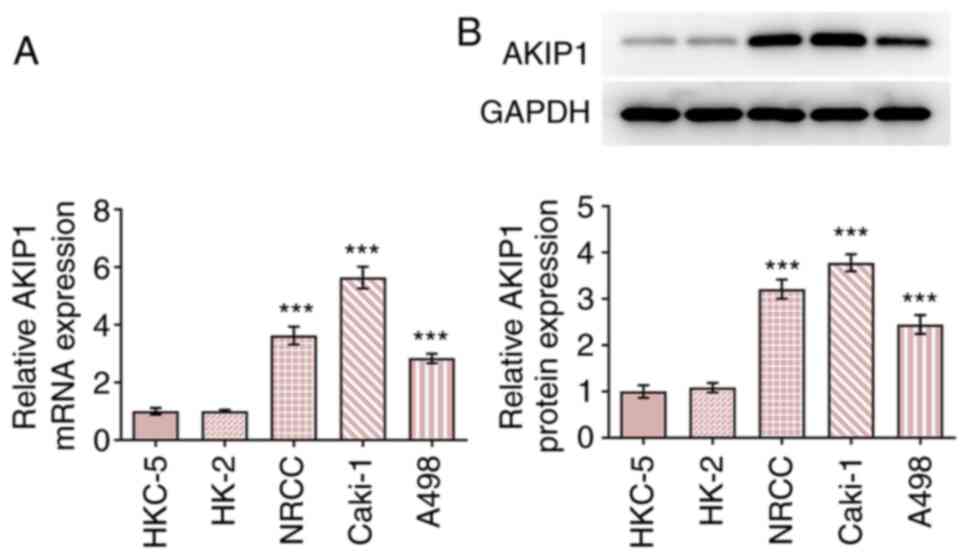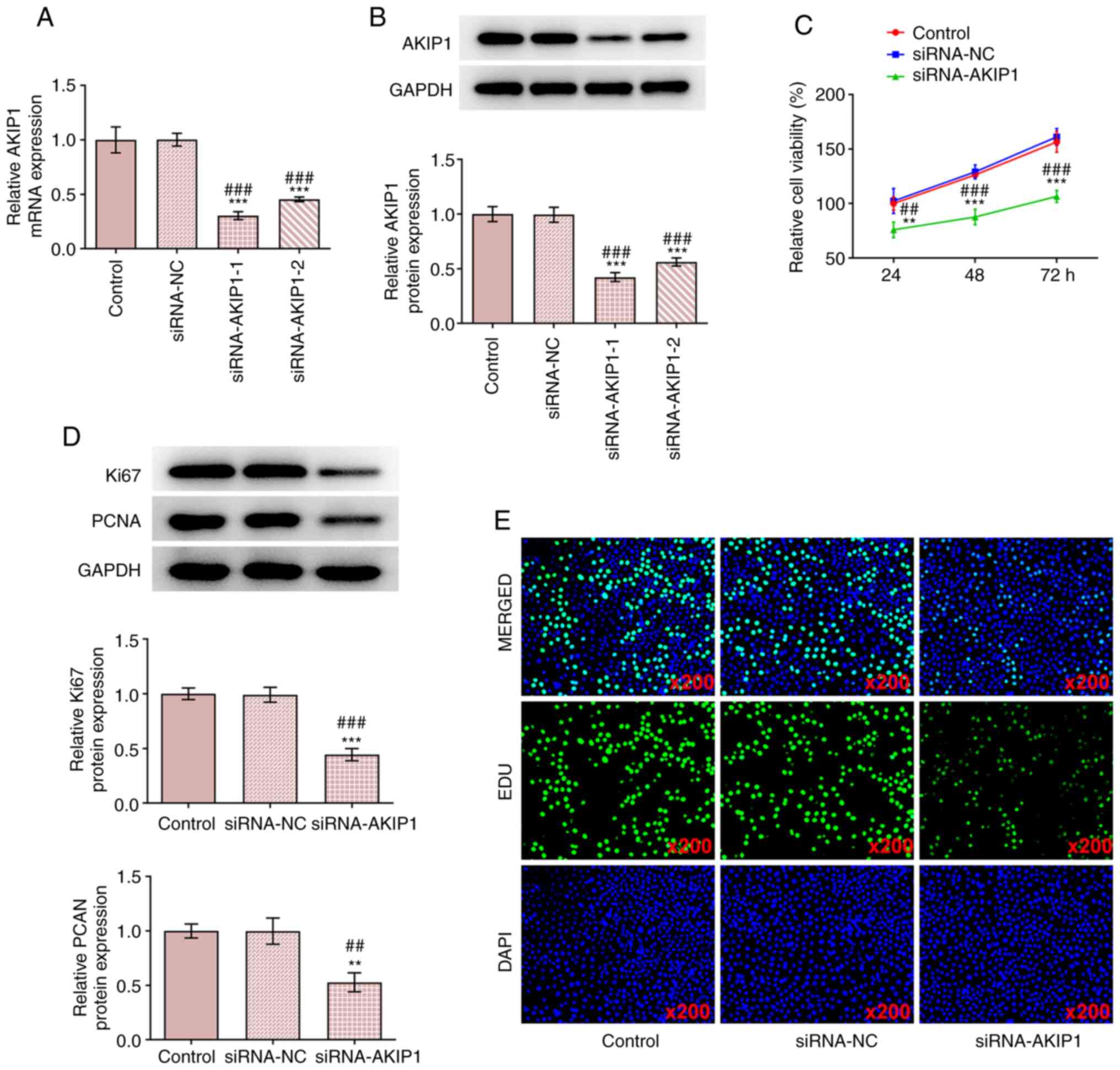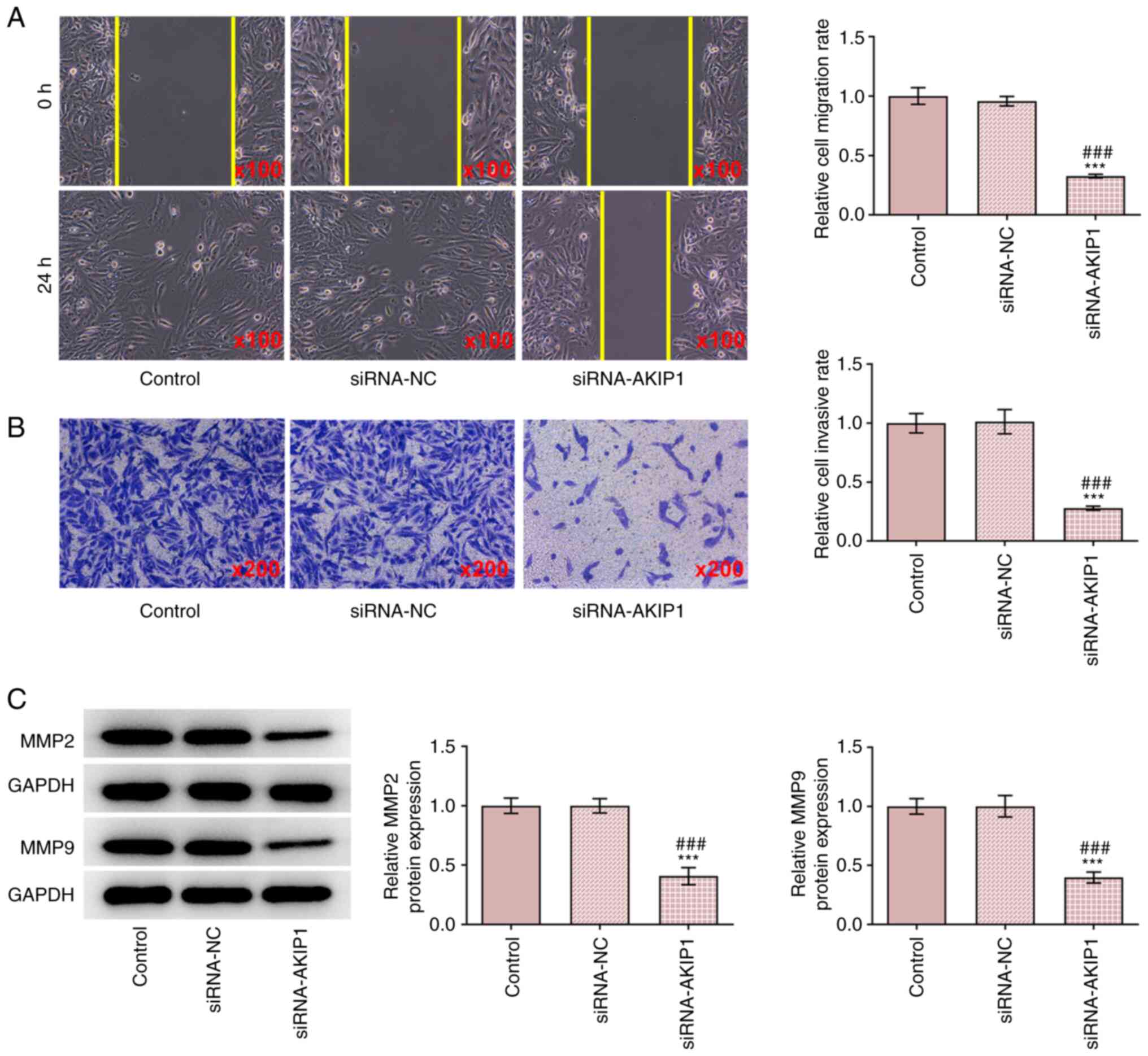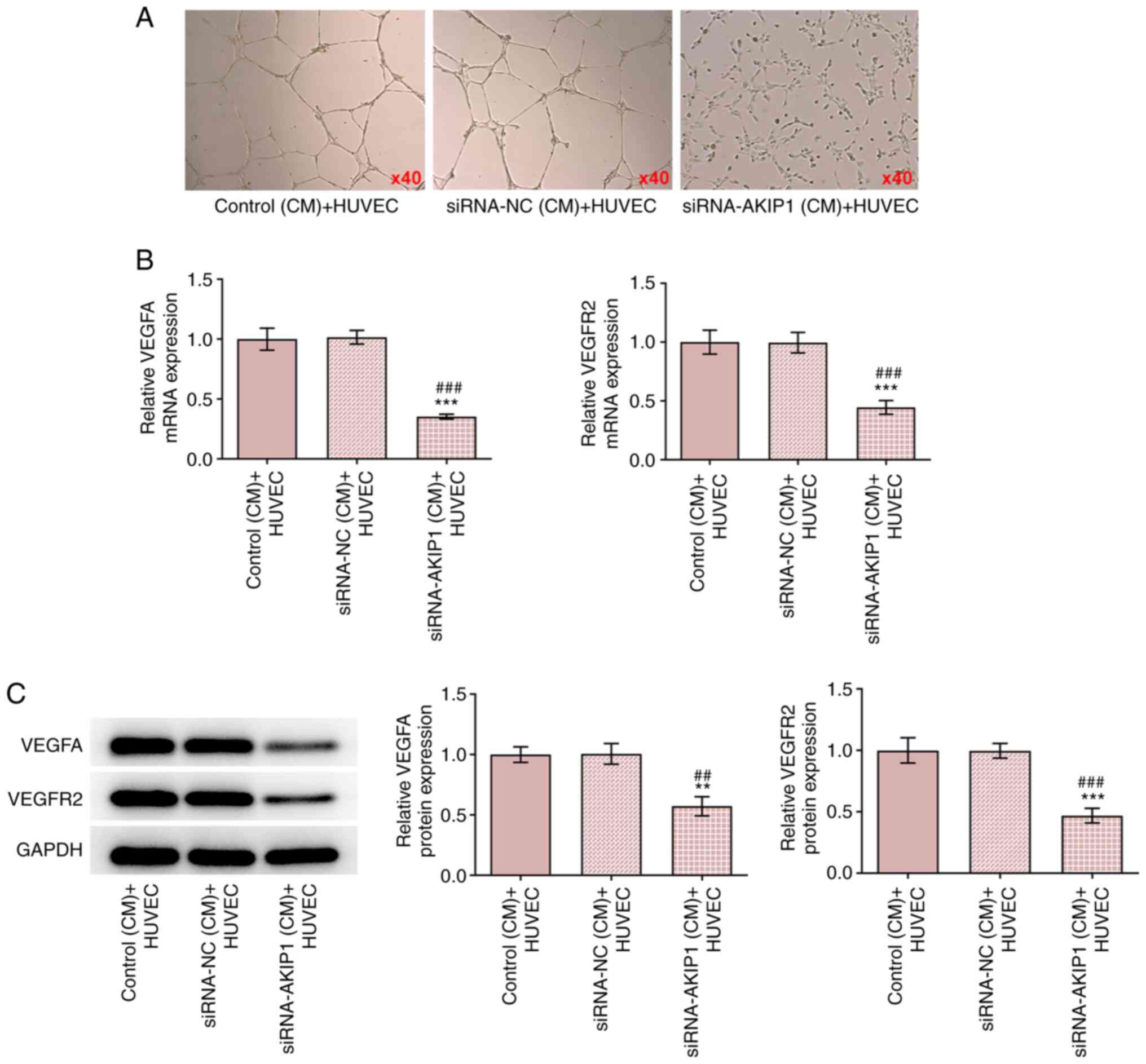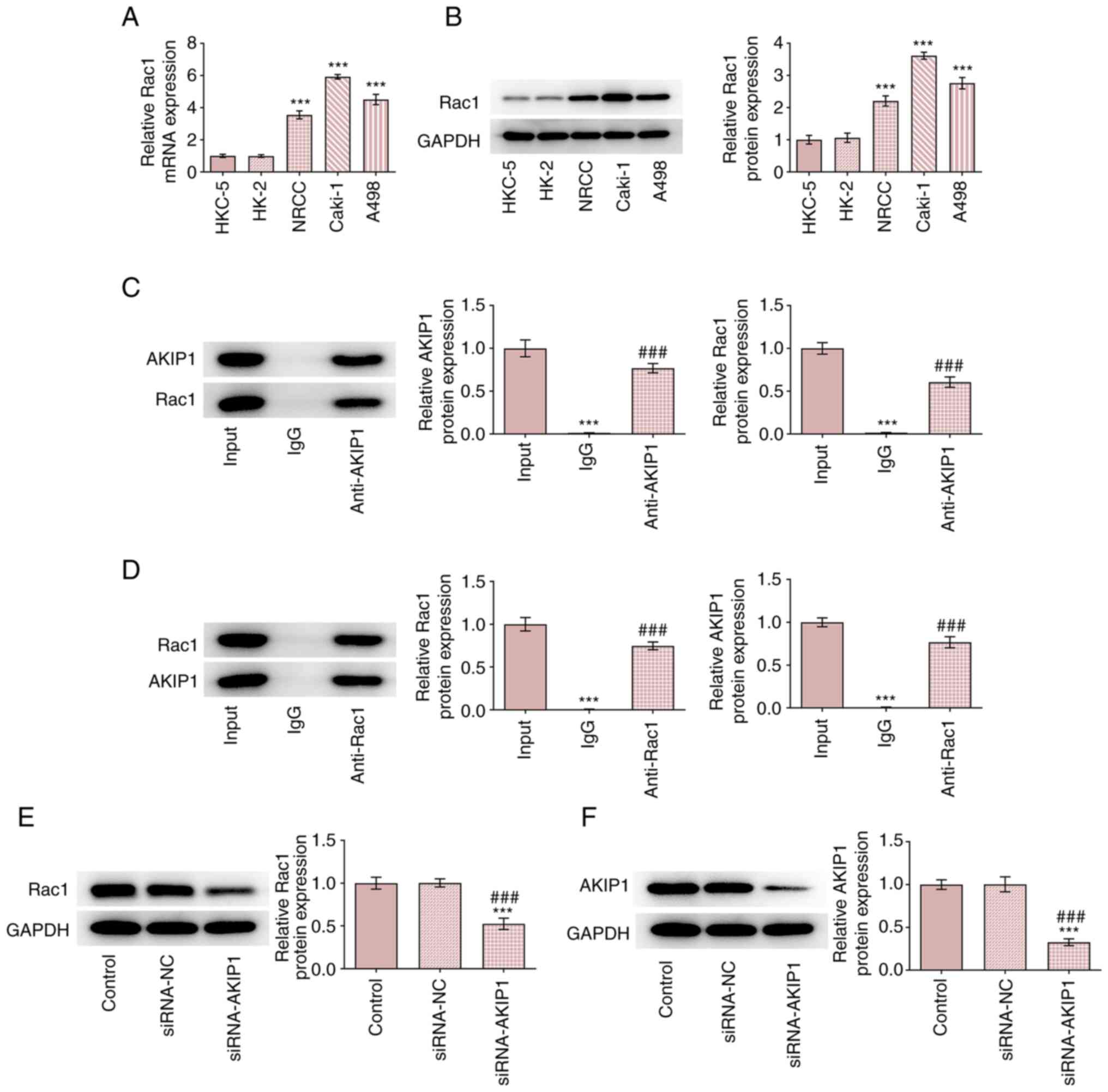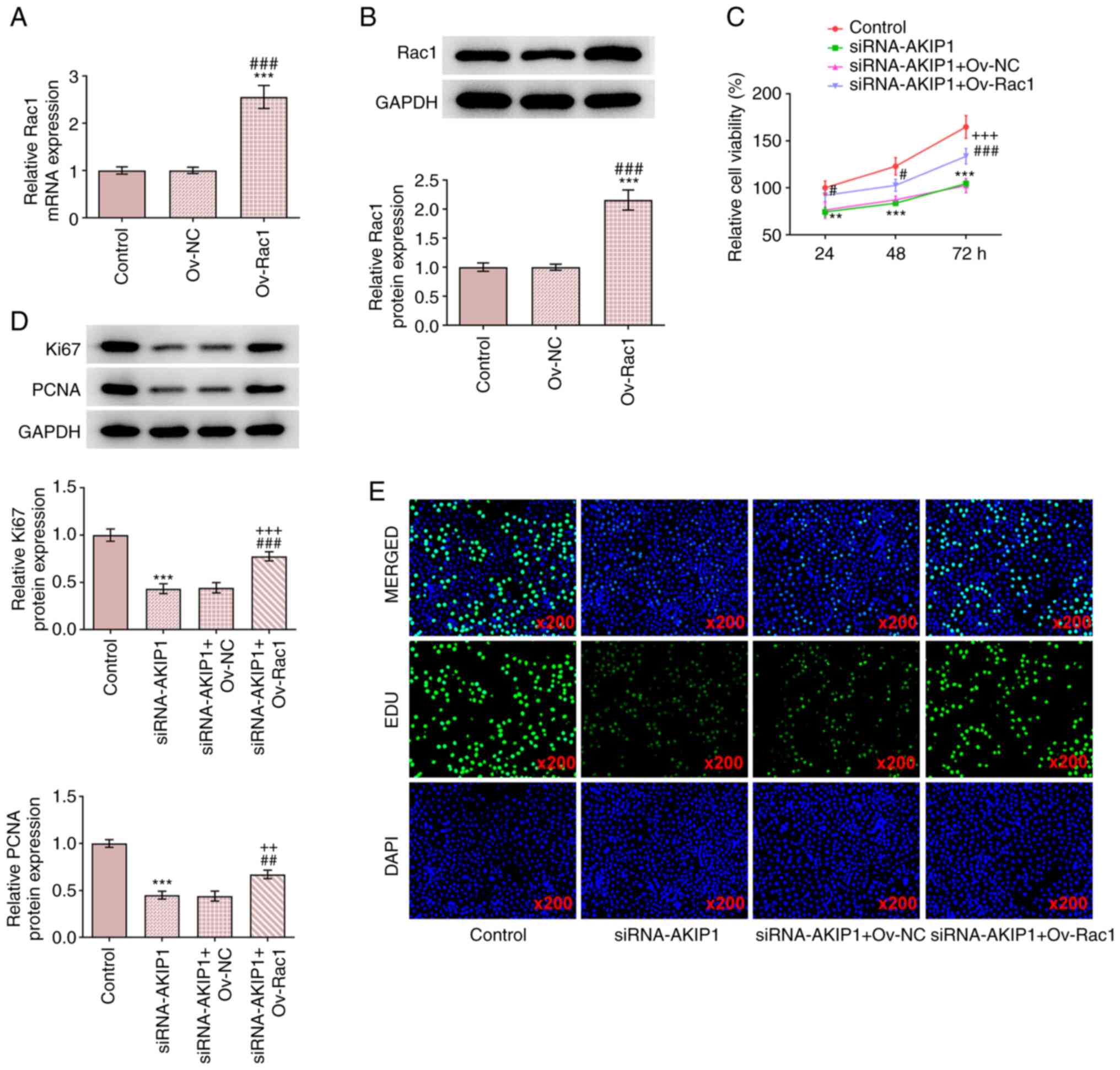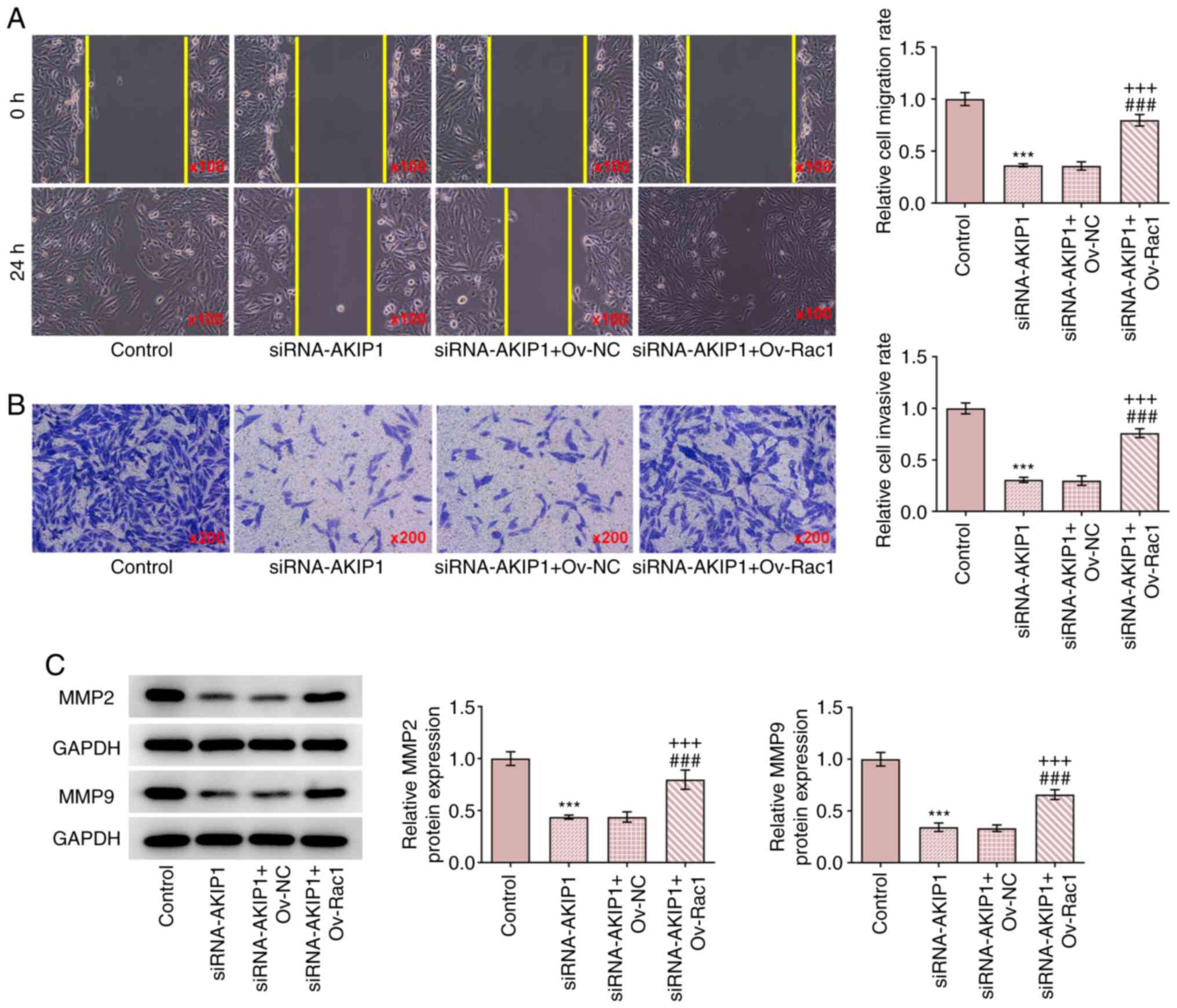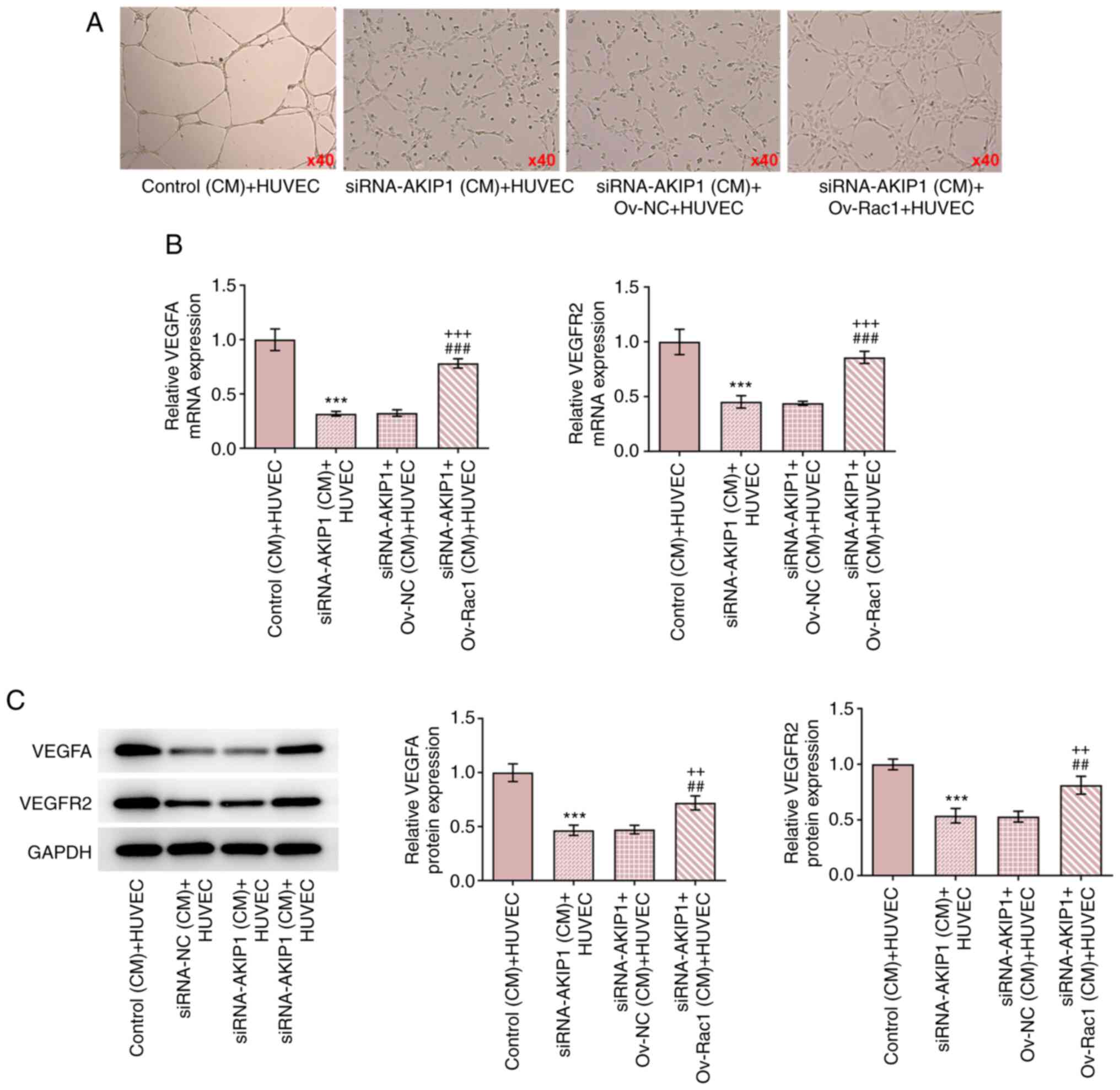A‑kinase interacting protein 1 regulates the cell proliferation, invasion, migration and angiogenesis of clear cell renal cell carcinoma cells and affects the ERK/c‑Myc signaling pathway by binding to Rac1
- Authors:
- Published online on: July 5, 2022 https://doi.org/10.3892/etm.2022.11489
- Article Number: 558
-
Copyright: © Zhang et al. This is an open access article distributed under the terms of Creative Commons Attribution License.
Abstract
Introduction
Clear cell renal cell carcinoma (ccRCC) is one of the commonest tumors of the urinary system. Each year 202,000 cases of ccRCC are diagnosed and there are 102,000 ccRCC-related deaths worldwide (1). In 2014 alone, there were ~66,800 newly confirmed cases and 13,860 ccRCC-related deaths in China (2). Although ultrasound and computed tomography have been widely used in clinical practice, ~1/3 of patients with ccRCC have already developed local or distant metastasis at the time of initial diagnosis and these patients have a poor prognosis (3). Therefore, it is important to explore and investigate novel diagnostic and therapeutic approaches for the clinical treatment of patients with ccRCC.
A-kinase interaction protein 1 (AKIP1) was initially reported as novel human breast cancer-associated gene 3, which encodes a selectively splicing proline-rich protein (4). Increasing evidence suggests that AKIP1 dysregulation is associated with physiological and pathological changes in numerous human malignancies and may be involved in tumor metastasis. It has previously been reported that in esophageal squamous cell carcinoma (ESCC) cell lines and clinical samples AKIP1 is upregulated which is associated with a poor prognosis in patients with ESCC (5). In addition, another study demonstrated that AKIP1 is a downstream target of NK2 homeobox 8 and a transcription factor of vascular endothelial growth factor (VEGF)C, which can induce lymphangiogenesis and lymphatic metastasis of ESCC (6). Furthermore, AKIP1 has been considered to be a potential metastatic agent in numerous types of human cancers (7-9). However, the clinical significance of its molecular function and the underlying mechanisms that promote distant metastasis are not well understood, especially in ccRCC. The latest clinical data suggests that AKIP1 expression is increased in ccRCC tissues and that AKIP1 expression levels are positively associated with TNM stage. These data also indicate that higher AKIP1 expression is associated with a worse prognosis (10). However, whether AKIP1 serves a role in promoting tumor processes, such as proliferation, invasion and migration in ccRCC cells, remains to be elucidated and its potential underlying mechanism remains unknown.
A previous study reported that AKIP1 binds to Rac1(11), which is involved in promoting the formation of cancer stemness in ccRCC (12). Rac1 inhibition can reduce the malignant progression of pituitary tumor-transforming gene-1-positive ccRCC (13), which indicates that Rac1 is involved in promoting ccRCC progression. Furthermore, a previous study demonstrated that Rac1 activates the ERK signaling pathway to promote colon cancer invasion and migration (14). In addition, Kyoto Encyclopedia of Genes and Genomes analysis indicated that ERK can activate the downstream cellular (c)-Myc signaling pathway.
The aim of the present study was to investigate whether AKIP1 can affect the proliferation, invasion, migration and angiogenesis of ccRCC cells via its interaction with Rac1. Furthermore, the influence of AKIP1 and Rac1 on the expression of the downstream ERK/c-Myc signaling pathway was explored.
Materials and methods
Cell culture
Normal renal epithelial cell lines (HKC-5 and HK-2), human umbilical vein endothelial cells (HUVECs) and ccRCC cell lines (NRCC, Caki-1 and A498) were purchased from BioVector NTCC, Inc. HKC-5 and HK-2 cells were cultured in minimum essential medium (MEM; Gibco; Thermo Fisher Scientific, Inc.) containing 10% FBS (Gibco; Thermo Fisher Scientific, Inc.) and 1% penicillin-streptomycin. ccRCC cells were cultured in DMEM/F12 (Gibco; Thermo Fisher Scientific, Inc.) containing 10% FBS and 1% penicillin-streptomycin. HUVECs were cultured in endothelial cell basal medium (EBM; Cambrex Bio Science Rockland Ltd.) containing endothelial cell growth medium supplements (EGM; Cambrex Bio Science Rockland Ltd.), 10% FBS, 100 IU/ml penicillin, and 100 mg/ml streptomycin. All cells were cultured at 37˚C in a humidified atmosphere of 95% air and 5% CO2. The approval of Ethics Committee of Beijing Ditan Hospital was received for the use of human primary cell lines.
Cell transfection
The small interfering (si)RNA-negative control (NC), siRNA-AKIP1-1/2, empty vector (Ov-NC) and Ov-Rac1 constructs were purchased from Guangzhou Ribo Biotechnology Co., Ltd. (https://www.ribobio.com/). ccRCC cells were seeded into 6-well plates at a density of 1x105 cells/well in complete medium and were cultured at 37˚C. When cells reached 70% confluency they were transfected with siRNA-NC (siB06525141922-1-5; 60 nM), siRNA-AKIP1-1 (siG1281084018-1-5; 60 nM), siRNA-AKIP1-2 (siG1281084034-1-5; 60 nM), Ov-NC and Ov-Rac1 at 37˚C using Lipofectamine® 3000 (Invitrogen; Thermo Fisher Scientific, Inc.) for 24 h. The cells were collected for further experimentation following 48 h of transfection.
Reverse transcription-quantitative PCR (RT-qPCR)
Total RNA was extracted from ccRCC cells using TRIzol® reagent (Thermo Fisher Scientific, Inc.) and complementary DNA was synthesized from RNA using the PrimeScript RT reagent kit (Takara Bio, Inc.). The following temperature protocol was used for reverse transcription: 37˚C for 50 min followed by 70˚C for 15 min. Subsequently, qPCR was performed using the Kapa SYBR® FAST qPCR Master Mix (Takara Bio, Inc.) and was analyzed using the MyGo PCR detection system (IT-IS Life Science Ltd.). The thermocycling conditions were: 10 min initial denaturation at 94˚C, 15 sec denaturation at 94˚C and 30 sec of annealing at 55˚C (40 cycles) and final extension for 1 min at 72˚C. The mRNA expression levels of AKIP1, VEGFA, VEGFR2 and Rac1 were quantified using the 2-∆∆Cq method (15) and were normalized to the internal reference gene GAPDH. The primer sequences used in the present study are as follows: AKIP1 forward, 5'-AGAACATCTCTAAGGACCTCTACAT-3' and reverse, 5'-TCCAGAATCAACTGCTACCACAT-3'; VEGFA forward, 5'-GGGCAGAATCATCACGAAGT-3' and reverse, 5'-TGGTGATGTTGGACTCCTCA-3'; VEGFR2 forward, 5'-CTCTTGGCCGTGGTGCCTTTG-3' and reverse, 5'-GTGTGTTGCTCCTTCTTTCAAC-3'; Rac1 forward, 5'-AAAATGTCCGTGCAAAGTGGT-3' and reverse, 5'-CTCGATCGTGTCTTTATCATCCC-3'; GAPDH forward, 5'-AATGGACAACTGGTCGTGGAC-3' and reverse, 5'-CCCTCCAGGGGATCTGTTTG-3'.
Western blotting
Total protein in ccRCC cells was extracted using RIPA buffer (Beyotime Institute of Biotechnology) and the protein concentration was determined using a BCA Protein Assay Kit (Thermo Fisher Scientific, Inc.). Total protein (40 µg total protein/lane) was separated using 10% SDS-PAGE. Separated protein was transferred to a PVDF membrane (MilliporeSigma). Subsequently membranes were blocked with 5% non-fat milk for 1 h at room temperature and were then incubated with primary antibodies overnight at 4˚C. The primary antibodies used were as follows: Anti-AKIP1 (1:1,000; cat. no. ab135996; Abcam), anti-Ki67 (1:5,000; cat. no. ab92742; Abcam), anti-proliferating cell nuclear antigen (PCNA; 1:5,000; ab92552; Abcam), anti-MMP2 (1:5,000; ab92536; Abcam), anti-MMP9 (1:5,000; ab76003; Abcam), anti-VEGFA (1:1,000; ab214424; Abcam), anti-VEGFR2 (1:5,000; ab134191; Abcam), anti-Rac1 (1:1,000; ab155938; Abcam), anti-p-ERK (1:1,000; ab201015; Abcam), anti-ERK (1:10,000; ab184699; Abcam), anti-c-Myc (1:1,000; ab32072; Abcam) and anti-GAPDH (1:2,500; ab9485; Abcam). Membranes were then washed in TBS with 0.1% Tween-20 three times. Following the primary incubation membranes were incubated with the HRP-conjugated secondary antibody (1:2,000; cat. no. ab6721; Abcam) at room temperature for 1 h. The blots were visualized using ECL reagent (Pierce; Thermo Fisher Scientific, Inc.) and the band intensity was semi-quantified using ImageJ 1.51 software (National Institutes of Health).
Cell Counting Kit-8 (CCK-8) assay
Following transfection, ccRCC cells were seeded into 96-well plates at a density of 2x103 cells/well and were incubated for 24, 48 and 72 h at 37˚C. A total of 10 µl CCK-8 solution (Dojindo Molecular Technologies, Inc.) was added to each well for 2 h at 37˚C. The optical density at 450 nm was assessed using a microplate reader.
5-Ethynyl-2'-deoxyuridine (EdU) staining assay
Following transfection, ccRCC cells were seeded into a culture flask and incubated with diluted EdU solvent for 24 h at room temperature. Subsequently, the cells were fixed with 4% paraformaldehyde for 10 min and stained with Alexa Fluor 594 (cat. no. ab150084; 1:200; Abcam) overnight at room temperature. Cell nuclei were counterstained with DAPI for 15 min at room temperature. Cell proliferation was observed using a fluorescence microscope (Eclipse 80i; Nikon Corporation).
Transwell assay
Following transfection, ccRCC cells were seeded at a density of 4x104 cells into the upper Transwell chamber that was pre-coated with Matrigel (BD Biosciences) for 1 h at 37˚C. In the lower chamber 1 ml DMEM/F12 medium was added. Subsequently the cells were incubated at 37˚C for 24 h. After removing the cells on the upper surface of the chamber the remaining cells were fixed in 4% paraformaldehyde for 10 min at room temperature. The cells were then stained with 0.1% crystal violet (Sangon Biotech Co., Ltd.) for 1 h at room temperature. The number of cells was quantified using a light microscope (Olympus Corporation) and invasive ability was assessed using ImageJ 1.51 software.
Wound healing assay
Following transfection, ccRCC cells were seeded into 6-well plates and incubated until >90% confluency. A sterile 200 µl pipette tip was used to create a 0.5-1 cm horizontal line. After washing with PBS the scratched cells were cultured in serum-free medium for 24 h. The width of the scratch was imaged at 0 and 24 h using a light microscope (Olympus Corporation) and the migratory ability of the cells was quantified using ImageJ 1.51 software (National Institutes of Health).
HUVEC tube-formation assay
The transfected ccRCC cells were cultured in MEM until they reached 70% confluency. Following washing with PBS, ccRCC cells were cultured in serum-free MEM for 48 h at 37˚C. The culture media (CM) was collected following centrifugation at 500 x g at room temperature for 10 min. Early passage (<Phase 4) HUVECs were seeded at 3x104 cells/well on Matrigel-coated 48-well plates. HUVECs were then incubated with the CM for 6 h at 37˚C. HUVEC tube formation was observed and imaged using a phase-contrast inverted microscope.
Co-immunoprecipitation (co-IP)
Following transfection, ccRCC cells were lysed using RIPA lysis buffer (Beyotime Institute of Biotechnology) containing 1% PMSF and 1% protease inhibitor, centrifuged at 24,148.8 x g for 10 min at 4˚C. A part of the cell lysate was isolated as input and 250 µl of lysates were incubated with 1 µg anti-AKIP1 (cat. no. LS-C309384; LSBio) or anti-Rac1 (cat. no. sc-514583; Santa Cruz Biotechnology, Inc.) and homologous IgG antibodies (cat. no. ab172730; Abcam and cat. no. sc-2025; Santa Cruz Biotechnology, Inc.) at 4˚C overnight. Subsequently, 25 µl protein A/G beads (Cell Signaling Technology, Inc.) were added to the lysis solution and the solution was incubated for 1 h at 4˚C. Then, the supernatant was centrifuged for 3 min at 1,509.3 x g at 4˚C. The beads were extracted and were incubated with protein loading buffer at 100˚C for 15 min to isolate the proteins, which were subsequently detected via western blotting.
Statistical analysis
Data are presented as the mean ± SD. All statistical analysis was performed using GraphPad Prism 8.0 software (GraphPad Software, Inc.). One-way ANOVA followed by Tukey's post hoc test was used to perform statistical analysis among more than two groups. P<0.05 was considered to indicate a statistically significant difference.
Results
AKIP1 expression levels increase in ccRCC cells
The results demonstrated that AKIP1 mRNA and protein expression levels were increased in ccRCC cells compared with normal renal epithelial cells. Furthermore, AKIP1 mRNA and protein expression levels in Caki-1 cells were the highest among all ccRCC cell lines tested (Fig. 1).
AKIP1 knockdown inhibits ccRCC cell proliferation
ccRCC cells were transfected with siRNA-NC or siRNA-AKIP1-1/2 and AKIP1 mRNA, and protein expression levels were determined. The results demonstrated that AKIP1 mRNA and protein expression levels were markedly decreased in the siRNA-AKIP1-1/2 groups compared with siRNA-NC group. The transfection efficiency in the siRNA-AKIP1-1 group was greater than that of the siRNA-AKIP1-2 group and therefore the siRNA-AKIP1-1 group was selected for use in the subsequent experiments (Fig. 2A and B). Following siRNA-AKIP1 transfection, the viability of Caki-1 cells (Fig. 2C) was decreased and the protein expression levels of proliferation markers including Ki67 and PCNA were also downregulated, which implied the inhibition of cell proliferation (Fig. 2D). The proliferation of Caki-1 cells was also suppressed by AKIP1 knockdown (Fig. 2E).
AKIP1 knockdown inhibits the invasion and migration of ccRCC cells
The results demonstrated that the invasion and migration of Caki-1 cells were inhibited in the siRNA-AKIP1 group compared with the control group, whereas no change was observed between the siRNA-NC and control groups (Fig. 3A and B). The protein expression levels of metastasis-associated proteins including MMP2 and MMP9 were downregulated by AKIP1 knockdown, suggesting that AKIP1 deficiency hampered the metastasis in ccRCC cells and they were not affected in the siRNA-NC group (Fig. 3C).
AKIP1 knockdown inhibits angiogenesis in ccRCC cells
The CM of siRNA-NC-transfected Caki-1 cells had no effect on HUVEC tube-formation, whereas tube formation was suppressed by AKIP1 knockdown (Fig. 4A). In addition, the mRNA and protein expression levels of VEGFA and VEGFR2 in HUVECs were decreased in the CM of siRNA-AKIP1-transfected Caki-1 cells (Fig. 4B and C).
AKIP1 potentially binds to Rac1 in ccRCC cells and AKIP1 downregulation inhibits Rac1 expression
The results demonstrated that Rac1 mRNA and protein expression levels were increased in ccRCC cells and that the highest expression levels of Rac1 were demonstrated in Caki-1 cells (Fig. 5A and B). co-IP experiments demonstrated that Rac1 co-precipitated with AKIP1 when an anti-AKIP1 antibody was used and AKIP1 co-precipitated with Rac1when an anti-Rac1 antibody was used (Fig. 5C and D). Following Caki-1 cell transfection with siRNA-NC and siRNA-AKIP1 the results demonstrated that there was no obvious change in expression levels of Rac1 and AKIP1 in the siRNA-NC group, whereas expression of Rac1 and AKIP1 decreased in the siRNA-AKIP1 group compared with the control (Fig. 5E and F).
Rac1 overexpression reverses the effects of AKIP1 silencing on the proliferation of ccRCC cells
The results demonstrated that Ov-Rac1-transfected Caki-1 cells exhibited upregulated Rac1 mRNA and protein expression levels (Fig. 6A and B). Rac1 overexpression also improved the viability of Caki-1 cells and promoted the protein expression of Ki67 and PCNA compared with the siRNA-AKIP1 group (Fig. 6C and D). In addition, EdU staining indicated that Rac1 overexpression reversed the effect of AKIP1 knockdown and enhanced the proliferation of Caki-1 cells (Fig. 6E).
Rac1 overexpression reverses the impacts of AKIP1 silencing on the invasion and migration of ccRCC cells
The results demonstrated that Rac1 overexpression increased the invasion and migration of Caki-1 cells transfected with siRNA-AKIP1 (Fig. 7A and B). In addition, Rac1 overexpression upregulated the protein expression levels of MMP2 and MMP9 in Caki-1 cells transfected with siRNA-AKIP1 (Fig. 7C). These results indicated that Rac1 overexpression may be able to reverse the effect of AKIP1 knockdown on the invasion and migration of Caki-1 cells.
Rac1 overexpression reverses the impacts of AKIP1 knockdown on the angiogenesis in ccRCC cells
The results demonstrated that HUVEC tube-formation was increased in the CM of Caki-1 cells transfected with siRNA-AKIP1 and Ov-Rac1, compared with the CM of Caki-1 cells transfected with siRNA-AKIP1 alone (Fig. 8A). The mRNA and protein expression levels of VEGFA and VEGFR2 were upregulated in HUVECs cultured in the CM of Caki-1 cells transfected with siRNA-AKIP1 and Ov-Rac1, compared with the CM of Caki-1 cells transfected with siRNA-AKIP1 alone (Fig. 8B and C).
Rac1 elevation countervails the impacts of AKIP1 depletion on the expression of ERK/c-Myc signaling pathway-associated proteins in ccRCC cells
The results demonstrated that AKIP1 knockdown inhibited the expression of phosphorylated (p)/total (t)-ERK and c-Myc in Caki-1 cells. Furthermore, Rac1 overexpression increased the expression levels of p/t-ERK and c-Myc in Caki-1 cells transfected with siRNA-AKIP1 (Fig. 9).
Discussion
AKIP1 was first identified in breast and prostate cancer cell lines and serves an important role in normal physiological processes (4). Recently, AKIP1 has been reported to act as an oncogene in common malignant tumors, including lung, liver and breast cancer, participating in the physiological and pathological changes of malignant tumors and promoting malignant biological behaviors, such as tumor proliferation, invasion and metastasis (6,9,16). AKIP1 is highly expressed in cervical cancer cells and the inhibition of AKIP1 expression in cervical cancer cells suppresses cell proliferation, tumor growth and angiogenesis in BALB/c nude mice (17). AKIP1 overexpression is also involved in cell proliferation, clonal formation and angiogenesis (17). A previous study reported that AKIP1 expression is upregulated in liver cancer tissues and is associated with early recurrence and a poor prognosis in patients. In vitro, AKIP1 promotes tumor cell invasion and colony growth and in vivo it promotes intrahepatic and lung metastasis (18). Although AKIP1 expression was previously demonstrated to be increased in ccRCC tissues, the regulating role of AKIP1 in the proliferation, invasion, migration and angiogenesis of ccRCC cells remains unknown. The results of the present study demonstrated that AKIP1 expression levels were upregulated in ccRCC cells consistent with previous studies. To assess the biological function of AKIP1 in ccRCC cells, the expression levels of AKIP1 in Caki-1 cells were knocked down using siRNA-AKIP1. The results demonstrated that AKIP1 knockdown potentially inhibited the proliferation, invasion, migration and angiogenesis of Caki-1 cells.
A previous study reported that AKIP1 can bind to Rac1(11). The present study demonstrated an interaction between AKIP1 and Rac1, and that AKIP1 knockdown downregulated Rac1 expression levels. Rac1, as a member of the Rho family, serves a role in cell proliferation, cell survival, cytoskeleton remodeling and gene transcription (19). Rac1 is expressed at low levels or not at all in normal human tissues, but it is increased in pancreatic (20), prostate (21), breast (22) and colorectal cancer (23), and other malignant tumor tissues or cells. In addition, this high expression of Rac1 is closely related to the degree of differentiation of tumor cells, the pathological classification, TNM staging and other phenotypes. A previous study using renal cancer tissues also demonstrated that Rac1 activation leads to renal cancer infiltration (24). The present study demonstrated that Rac1 expression levels were also upregulated in ccRCC cells, which was consistent with Rac1 expression levels in other types of cancer. These results indicated that Rac1 overexpression could potentially reverse the downregulation of AKIP1 to promote the proliferation, invasion, migration and angiogenesis of Caki-1 cells.
Rac1 activates the ERK signaling pathway in hepatocellular carcinoma and colon cancer to regulate the proliferation, invasion and migration of cancer cells (25,26). Zhao et al (27) reported that the slit guidance ligand 2/roundabout guidance receptor 1 axis promotes the malignant progression of osteosarcoma cells via activation of the proto-oncogene tyrosine protein kinase Src/ERK/c-Myc/6-phosphofructo-2-kinase/fructose-2,6-bisphosphatase 2 signaling pathway. ERK1/2 promotes aerobic glycolysis of hepatocellular carcinoma cells via the regulation of differentiation inhibitor 1 expression and via the formation of an intracellular message transfer chain with c-Myc (28). The ERK/c-Myc signaling pathway is also suppressed to reduce the proliferation of human epithelial ovarian cancer cells (29). In the present study it was demonstrated that AKIP1 knockdown suppressed the expression levels of p-ERK and c-Myc by downregulating Rac1 expression. However, Rac1 overexpression reversed this inhibitory effect, which potentially activated the ERK/c-Myc signaling pathway.
In conclusion, AKIP1 knockdown potentially suppressed the cell proliferation, invasion, migration and angiogenesis of ccRCC cells and may have suppressed the ERK/c-Myc signaling pathway by binding to Rac1. However, this phenomenon was potentially reversed by Rac1 overexpression. Therefore, the results of the present study provided a theoretical basis for the treatment of ccRCC and showed an interaction between AKIP1 and Rac1, while the functional relationship between these two proteins will be explored in the future.
Acknowledgements
Not applicable.
Funding
Funding: The present study was funded by Beijing Medical Award Foundation (grant no. YXJL-2021-0800-0410).
Availability of data and materials
The datasets used and/or analyzed during the current study are available from the corresponding author on reasonable request.
Authors' contributions
YZ, HZ, ZH and QL contributed to the study design. XW, XL, PY and SJ performed the experiments and analyzed the data. YZ and HZ contributed to the experiments and writing and performed the secondary data analyses and revising the manuscript for intellectual and scientific content. ZH and XW contributed to the conception of the study. YZ and HZ confirm the authenticity of all the raw data. All authors read and approved the manuscript.
Ethics approval and consent to participate
Not applicable.
Patient consent for publication
Not applicable.
Competing interests
The authors declare that they have no competing interests.
References
|
Siegel R, Ma J, Zou Z and Jemal A: Cancer statistics, 2014. CA Cancer J Clin. 64:9–29. 2014.PubMed/NCBI View Article : Google Scholar | |
|
Chen W, Zheng R, Baade PD, Zhang S, Zeng H, Bray F, Jemal A, Yu XQ and He J: Cancer statistics in China, 2015. CA Cancer J Clin. 66:115–132. 2016.PubMed/NCBI View Article : Google Scholar | |
|
Wu Y, Wang YQ, Weng WW, Zhang QY, Yang XQ, Gan HL, Yang YS, Zhang PP, Sun MH, Xu MD and Wang CF: A serum-circulating long noncoding RNA signature can discriminate between patients with clear cell renal cell carcinoma and healthy controls. Oncogenesis. 5(e192)2016.PubMed/NCBI View Article : Google Scholar | |
|
Kitching R, Li H, Wong MJ, Kanaganayakam S, Kahn H and Seth A: Characterization of a novel human breast cancer associated gene (BCA3) encoding an alternatively spliced proline-rich protein. Biochim Biophys Acta. 1625:116–121. 2003.PubMed/NCBI View Article : Google Scholar | |
|
Lin C, Song L, Liu A, Gong H, Lin X, Wu J, Li M and Li J: Overexpression of AKIP1 promotes angiogenesis and lymphangiogenesis in human esophageal squamous cell carcinoma. Oncogene. 34:384–393. 2015.PubMed/NCBI View Article : Google Scholar | |
|
Mo D, Li X, Li C, Liang J, Zeng T, Su N, Jiang Q and Huang J: Overexpression of AKIP1 predicts poor prognosis of patients with breast carcinoma and promotes cancer metastasis through Akt/GSK-3β/Snail pathway. Am J Transl Res. 8:4951–4959. 2016.PubMed/NCBI | |
|
Jiang W, Yang W, Yuan L and Liu F: Upregulation of AKIP1 contributes to metastasis and progression and predicts poor prognosis of patients with colorectal cancer. Onco Targets Ther. 11:6795–6801. 2018.PubMed/NCBI View Article : Google Scholar | |
|
Sun Y, Shi G, Ma C, Jiao J, Liu Y, Gao Q, Zhang X and Feng Q: Upregulation of a kinase interacting protein 1 in tongue squamous cell carcinoma correlates with lymph node metastasis and poor overall survival. Medicine (Baltimore). 100(e25278)2021.PubMed/NCBI View Article : Google Scholar | |
|
Guo X, Zhao L, Cheng D, Mu Q, Kuang H and Feng K: AKIP1 promoted epithelial-mesenchymal transition of non-small-cell lung cancer via transactivating ZEB1. Am J Cancer Res. 7:2234–2244. 2017.PubMed/NCBI | |
|
Peng H, Zhang R and Zhang H: A-kinase interacting protein 1 high expression correlates with advanced tumor stage and poor overall survival in surgical patients with clear cell renal cell carcinoma. Medicine (Baltimore). 99(e20742)2020.PubMed/NCBI View Article : Google Scholar | |
|
Yao C, Yu KP, Philbrick W, Sun BH, Simpson C, Zhang C and Insogna K: Breast cancer-associated gene 3 interacts with Rac1 and augments NF-κB signaling in vitro, but has no effect on RANKL-induced bone resorption in vivo. Int J Mol Med. 40:1067–1077. 2017.PubMed/NCBI View Article : Google Scholar | |
|
Chen L, Zhang D, Ding T, Liu F, Xu X, Tian Y, Xiao J and Shen H: LncRNA NR2F2-AS1 Upregulates Rac1 to increase cancer stemness in clear cell renal cell carcinoma. Cancer Biother Radiopharm. 35:301–306. 2020.PubMed/NCBI View Article : Google Scholar | |
|
Hsieh YY, Liu TP and Yang PM: In silico repurposing the Rac1 inhibitor NSC23766 for treating PTTG1-high expressing clear cell renal carcinoma. Pathol Res Pract. 215(152373)2019.PubMed/NCBI View Article : Google Scholar | |
|
Zhang T, Wang Z, Liu Y, Huo Y, Liu H, Xu C, Mao R, Zhu Y, Liu L, Wei D, et al: Plastin 1 drives metastasis of colorectal cancer through the IQGAP1/Rac1/ERK pathway. Cancer Sci. 111:2861–2871. 2020.PubMed/NCBI View Article : Google Scholar | |
|
Livak KJ and Schmittgen TD: Analysis of relative gene expression data using real-time quantitative PCR and the 2(-Delta Delta C(T)) method. Methods. 25:402–408. 2001.PubMed/NCBI View Article : Google Scholar | |
|
Ma D, Li M, Su J and Zhang S: BCA3 contributes to the malignant progression of hepatocellular carcinoma through AKT activation and NF-κB translocation. Exp Cell Res. 362:142–151. 2018.PubMed/NCBI View Article : Google Scholar | |
|
Zhang W, Wu Q, Wang C, Yang L, Liu P and Ma C: AKIP1 promotes angiogenesis and tumor growth by upregulating CXC-chemokines in cervical cancer cells. Mol Cell Biochem. 448:311–320. 2018.PubMed/NCBI View Article : Google Scholar | |
|
Cui Y, Wu X, Lin C, Zhang X, Ye L, Ren L, Chen M, Yang M, Li Y, Li M, et al: AKIP1 promotes early recurrence of hepatocellular carcinoma through activating the Wnt/β-catenin/CBP signaling pathway. Oncogene. 38:5516–5529. 2019.PubMed/NCBI View Article : Google Scholar | |
|
Bosco EE, Mulloy JC and Zheng Y: Rac1 GTPase: A ‘Rac’ of all trades. Cell Mol Life Sci. 66:370–374. 2009.PubMed/NCBI View Article : Google Scholar | |
|
Zhang S, Shi W, Hu W, Ma D, Yan D, Yu K, Zhang G, Cao Y, Wu J, Jiang C and Wang Z: DEP Domain-Containing Protein 1B (DEPDC1B) promotes migration and invasion in pancreatic cancer through the Rac1/PAK1-LIMK1-Cofilin1 signaling pathway. Onco Targets Ther. 13:1481–1496. 2020.PubMed/NCBI View Article : Google Scholar | |
|
Kato T, Kawai K, Egami Y, Kakehi Y and Araki N: Rac1-dependent lamellipodial motility in prostate cancer PC-3 cells revealed by optogenetic control of Rac1 activity. PLoS One. 9(e97749)2014.PubMed/NCBI View Article : Google Scholar | |
|
Tian Y, Xu L, He Y, Xu X, Li K, Ma Y, Gao Y, Wei D and Wei L: Knockdown of RAC1 and VASP gene expression inhibits breast cancer cell migration. Oncol Lett. 16:2151–2160. 2018.PubMed/NCBI View Article : Google Scholar | |
|
Xie N, Meng Q, Zhang Y, Luo Z, Xue F, Liu S, Li Y and Huang Y: MicroRNA-142-3p suppresses cell proliferation, invasion and epithelial-to-mesenchymal transition via RAC1-ERK1/2 signaling in colorectal cancer. Mol Med Rep. 24(568)2021.PubMed/NCBI View Article : Google Scholar | |
|
Wacker I and Behrens J: Activin B antagonizes RhoA signaling to stimulate mesenchymal morphology and invasiveness of clear cell renal cell carcinomas. PLoS One. 9(e111276)2014.PubMed/NCBI View Article : Google Scholar | |
|
Wang LL, Luo J, He ZH, Liu YQ, Li HG, Xie D and Cai MY: STEAP3 promotes cancer cell proliferation by facilitating nuclear trafficking of EGFR to enhance RAC1-ERK-STAT3 signaling in hepatocellular carcinoma. Cell Death. Dis. 12(1052)2021.PubMed/NCBI View Article : Google Scholar | |
|
Jiang QH, Wang AX and Chen Y: Radixin enhances colon cancer cell invasion by increasing MMP-7 production via Rac1-ERK pathway. ScientificWorldJournal. 2014(340271)2014.PubMed/NCBI View Article : Google Scholar | |
|
Zhao SJ, Shen YF, Li Q, He YJ, Zhang YK, Hu LP, Jiang YQ, Xu NW, Wang YJ, Li J, et al: SLIT2/ROBO1 axis contributes to the Warburg effect in osteosarcoma through activation of SRC/ERK/c-MYC/PFKFB2 pathway. Cell Death Dis. 9(390)2018.PubMed/NCBI View Article : Google Scholar | |
|
Sharma BK, Kolhe R, Black SM, Keller JR, Mivechi NF and Satyanarayana A: Inhibitor of differentiation 1 transcription factor promotes metabolic reprogramming in hepatocellular carcinoma cells. FASEB J. 30:262–275. 2016.PubMed/NCBI View Article : Google Scholar | |
|
Dai L, Wang W, Liu Y, Song K and Di W: Inhibition of sphingosine kinase 2 down-regulates ERK/c-Myc pathway and reduces cell proliferation in human epithelial ovarian cancer. Ann Transl Med. 9(645)2021.PubMed/NCBI View Article : Google Scholar |



